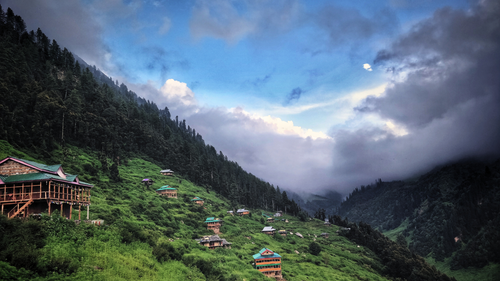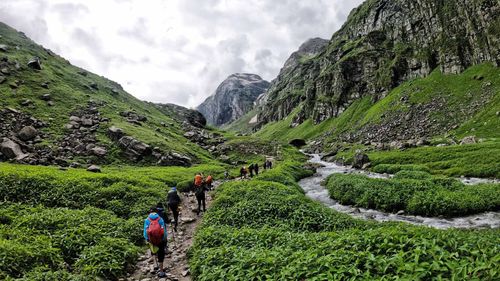Himachal Pradesh is one of the favourite destinations of travellers. But real adventure seekers cannot afford to miss out on the lesser-known, culturally vibrant and unique places that exist in Himachal. Malana undoubtedly tops this list of mysterious places with unusual history and a fascinating way of life.
You’re probably wondering what’s so unique about this little village in Parvati Valley. But globetrotters worldwide find this the treasure trove of premium cannabis. Located in the lush green, snow-covered mountains of Malana Nala, this village is 9,500 ft. above sea level. Not only is this village home to an indigenous tribe with an intriguing culture, but the society here also promotes a way of life close to nature and away from all the chaos we are accustomed to!
Nine things about Malana you must know
1. India’s little Greece resides in Malana

Locals claim that they are the descendants of Alexander the Great. It is believed that some soldiers from Alexander the Great’s army took refuge in this village after a battle and eventually settled there. Even the local court system exhibits qualities of the ancient Greek system! Read on to know how locals settle disputes!
2. No messing around with locals
If you are travelling to Malana, be sure to not touch locals or their possessions without permission. The villagers are undoubtedly friendly towards outsiders but you must keep your sweet distance from them and their properties. The shopkeepers too, do not encourage physical contact and will ask you to keep money on the counter! So what happens if you accidentally touch them? They’ll immediately rush for a shower because coming in contact with an outsider is against their traditional rules. Hence, you will find that goods are exchanged by throwing where there is no physical contact and the earth and surrounding air are the only links!
3. The superior perspective: Malana native supremacy
The locals view themselves as superior to the rest, which explains their ‘no physical contact’ policy. They deem their language ‘Kanashi’ sacred and take offence if an outsider tries to use it. Entry to their temples is restricted for tourists because they consider outsiders as ‘untouchables.’ However, this could also be linked to maintaining the sanctity of their traditions and culture.
4. Photos - sure, videos - a big NO
Although reserved towards outsiders, you will find that the locals are quite enthusiastic about posing for pictures! They are against videography but will happily pose for a photograph if you point your camera at them! The ban on videography is probably because they wish to preserve the secrecy of their lifestyle, traditions and culture. So, your list of things to do in Malana must include capturing images and skipping the videos!
5. Conflicts resolved via the death of lambs
Since a little of Greece remains in Malana, some of its methods of law and order still reflect in the way of life here. Malana’s judiciary is very different from that of the country. They believe more in a godly approach than reason. So, how do you think they resolve conflicts between citizens? An obvious answer is that they do not involve the police. The next, rather amusing way is poisoning a lamb owned by both parties in conflict and waiting to see whose lamb dies first. The one whose lamb dies first loses the case. Now, that’s unheard of!
6. Festivals celebrated in Malana
Two major celebrations are held here - Malana Fagli in mid of February and Malana Shaun on August 15. Malana Fagli is a festival where a group of people wear demon-like masks and cannabis leaves and dance around the house spreading cow dung on the walls. This practice also provides insulation from the cold. Malana Shaun on the other hand is another grand affair where some locals dress up in their traditional attire called pattu (made of sheep wool), offer prayers to God, sacrifice a sheep and rejoice among themselves.
7. Architecture of houses
There is a common architecture seen across houses in Malana. They usually have two-three storeys with dedicated names and purposes. The ground floor is called Khudang and functions as a cattle shed. The first floor is called Gaying and functions as a store for wool, and eatables. The top floor is called Pati and functions as the actual living quarters. The houses have an inner wall of mud and are built with alternate bands of limber and stove.
8. Low literacy index
You will be disheartened to know that so far there have been only two students in Malana who have finished their twelfth. There is a dedicated primary school and middle school but the turn-up is really low. The primary school is one run by the government and comes with a midday meal scheme. But despite this and free books being provided to female students, not many continue with their education here.
9. Taboos are a thing here
By now you must have figured that Malana comes with a lot of taboos. Your list of things to do in Malana must be respectful of those so that your adventurous trip remains fun throughout. Some rules to never forget are - no fixing nails on a tree and no burning of wood in Malana forests. Further, hunting of wild animals without permission of the village council is prohibited and seeking police intervention comes with a fine of 1000 Rs. So, tread with caution.
Frequently asked questions
1. How to avoid infuriating the Malana locals?
The answer is simple - adhere to their rules and respect their traditional beliefs. The foremost among these is the no physical contact policy. Further, be mindful of not making videos, or trying to speak the local language (even if you have it figured). While this may seem limiting, there are many things to do in Malana, but the sheer novelty of the experience of interacting with such a unique tribe is what excites us.
2. What else to see in Malana?
The top things to do in Malana include trekking and enjoying its natural beauty. Further, if you seek spiritual guidance, then Malana village might be the place for you. Embrace the calmness of this place as you sit under the shade of its tall deodar trees.





_1738827272926_thumb_500.jpeg)

